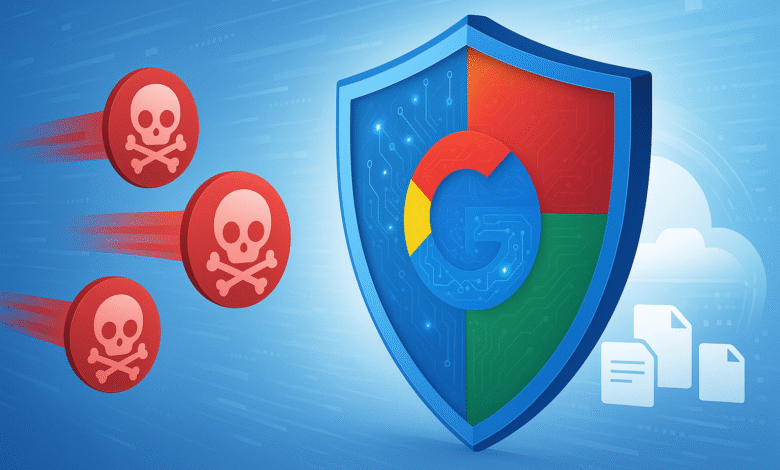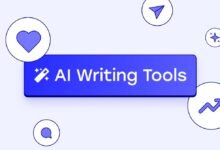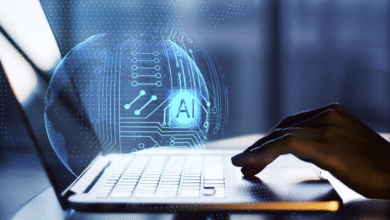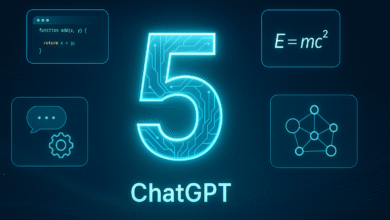Google’s Latest AI Ransomware Defense: A Game-Changer in Cloud Security

Ransomware attacks have become the digital equivalent of a wildfire, spreading rapidly through networks and leaving devastation in their wake. In 2024 alone, ransomware accounted for 21% of all cyber intrusions investigated by security experts, with each incident costing organizations an average of more than $5 million. That’s not just a number on a spreadsheet—it’s shuttered hospitals, paralyzed school systems, and crippled manufacturing operations.
Google has just rolled out something that could change the game entirely. Their new AI-powered ransomware defense for Drive for Desktop represents a fundamental shift in how we protect our files. Instead of just trying to keep the bad guys out, Google’s approach focuses on stopping ransomware from doing what it does best: corrupting your important files and making them unusable.
This isn’t another antivirus update or security patch. It’s an entirely new layer of protection that uses artificial intelligence trained on millions of real-world ransomware samples to detect attacks in progress and shut them down before they can spread. Let’s break down what this means for your data security and why it matters.
What Makes Google’s AI Ransomware Defense Different
The Problem with Traditional Ransomware Protection
For years, we’ve relied on antivirus software to catch ransomware at the door. The logic was simple: detect malicious code before it runs, quarantine it, and call it a day. But here’s the thing—that approach hasn’t been working as well as we need it to.
Modern ransomware variants have gotten frighteningly good at slipping past traditional defenses. They use sophisticated evasion techniques, constantly morphing their code to avoid detection. By the time your antivirus recognizes a new variant, the damage is often already done. According to Mandiant’s investigations in the Asia Pacific region, 89% of organizations only learned about ransomware attacks from external sources like law enforcement or the attackers themselves—not from their own security systems.
Google’s New Approach: Stop the Damage, Not Just the Entry
Google’s ransomware detection system takes a different approach. Rather than only trying to prevent ransomware from getting in (though that’s still important), it focuses on detecting and stopping the attack while it’s happening.
The system uses a specialized AI model that Google trained on millions of real-world ransomware samples collected from multiple sources, including consumer Drive data, Mandiant threat intelligence, and VirusTotal’s extensive malware database. This training allows the model to recognize the telltale signs of a ransomware attack in progress—specifically, attempts to encrypt or corrupt large numbers of files.
When the AI detects suspicious activity that matches ransomware behavior, Drive for Desktop immediately pauses syncing of the affected files. This creates what security experts call a “protective bubble” around your cloud storage, preventing the ransomware from spreading from your local device to your Google Drive and potentially to other devices synced to the same account.
How the AI Ransomware Detection Works
The Technology Behind the Protection
Google’s approach to ransomware prevention is built on several key technological components that work together seamlessly.
The detection engine continuously monitors file changes on your device. It’s looking for specific patterns that indicate malicious file encryption—the hallmark of a ransomware attack. According to Luke Camery, Product Manager for Security and Compliance at Google Workspace, the system typically kicks in after detecting changes to three to four files. Given the high precision of the model, users shouldn’t expect to lose more than five files before the system intervenes.
What makes this machine learning approach particularly effective is its ability to adapt. The model doesn’t rely on a static database of known threats. Instead, it continuously learns from new examples, making it effective against novel ransomware variants that your traditional antivirus might miss. Google designed the model to handle virtually any file format—not just PDFs or Microsoft Office documents, but CAD files, images, and basically everything except binary files.
The Detection and Response Process
Here’s what happens when ransomware strikes:
- Initial Detection: The AI model identifies suspicious file modifications that match ransomware behavior patterns
- Immediate Intervention: Drive for Desktop automatically pauses syncing of affected files
- Alert Notification: You receive both a desktop notification and an email alert about the detected threat
- Guided Recovery: The system provides clear instructions for restoring your files to their pre-attack state
- Admin Oversight: IT administrators receive alerts in the Admin console with detailed audit logs
The entire process takes just minutes, dramatically reducing the window of vulnerability compared to traditional threat detection methods that might take hours or even days to identify and respond to an attack.
Key Features and Benefits
Automatic Sync Pausing
The standout feature of Google’s AI ransomware protection is its automatic response. When ransomware is detected, the system doesn’t wait for human intervention. It immediately stops syncing affected files to the cloud, containing the attack before it can corrupt your cloud-based data.
This automatic pause is crucial because ransomware works fast. In traditional scenarios, by the time you realize you’ve been hit, the malware has already encrypted hundreds or thousands of files and synced those corrupted versions to your cloud storage. Google’s system breaks that chain of infection.
Simple File Restoration
After an attack is detected and your device is cleaned, restoring your files is remarkably straightforward. Unlike older recovery methods that involve re-imaging devices or paying for expensive third-party recovery tools, Google’s process takes just a few clicks through an intuitive web interface.
You can restore multiple files to their previous, healthy state from right before the attack occurred. This rapid recovery capability minimizes both user interruption and data loss. The system works across various file types, including files created with Microsoft Windows and Office applications.
No Additional Cost for Most Users
Perhaps one of the most significant aspects of this new protection is its availability. The ransomware detection, alerting, and file restoration capabilities are included in most Google Workspace commercial plans at no additional cost. Even free Google Drive users get access to the file restoration capability.
This democratization of advanced security features means that small businesses and individual users get the same level of protection as large enterprises—a rarity in the cybersecurity world.
Enterprise-Grade Controls
For IT administrators, the system provides comprehensive oversight through the Workspace Admin console. Administrators receive alerts when ransomware activity is detected across their networks, can review detailed audit logs, and maintain the controls to disable detection and restoration capabilities for end users if needed.
This balance between automated protection and administrative control gives organizations the flexibility to manage security according to their specific needs and policies.
Comparing Google’s Solution to Competitors
How It Stacks Up Against Microsoft OneDrive
Microsoft offers a similar detection and recovery workflow for its OneDrive storage service as part of Microsoft 365 subscriptions. However, there’s a critical difference: Google’s solution automatically intervenes and halts file synchronization when ransomware is active.
Microsoft’s approach relies more heavily on detection and post-attack recovery, but doesn’t automatically pause syncing in real-time. This means potentially more files could be affected before the attack is contained.
Box and Dropbox Solutions
Document storage vendors like Box and Dropbox have also implemented AI-powered malware detection systems. Box offers its Shield protective system with machine learning-based detection, while Dropbox provides similar capabilities.
However, both Box and Dropbox focus primarily on detection and recovery rather than active intervention. Google’s automatic sync-pausing represents a more proactive approach to limiting damage during an active attack.
The key differentiator is speed of response. While other platforms may alert you to a problem and help you recover afterward, Google’s system actively works to prevent the spread of corruption in real-time.
What This Means for Different Users
For Business Organizations
If you’re running a business, the financial implications of this technology are significant. With the average ransomware attack cost exceeding $5 million, any tool that can reduce that exposure is worth serious consideration.
Industries particularly vulnerable to ransomware—healthcare, retail, education, manufacturing, and government—stand to benefit enormously. These sectors often face operational disruptions that go beyond just data loss. A hospital can’t function without access to patient records. A manufacturing plant can’t run production lines if its systems are locked.
Google’s AI-powered defense adds a critical safety net. It won’t prevent every attack, but it can significantly limit the damage and reduce recovery time, helping maintain business continuity even when prevention fails.
For Individual Users
Even if you’re not running a business, this matters. Personal ransomware attacks have surged in recent years, targeting everyone from freelancers to retirees. Your family photos, tax documents, and personal projects are valuable—at least to you—and ransomware doesn’t discriminate.
The fact that even free Google Drive users get access to the restoration capability means you have professional-grade protection without needing an IT department or paying for expensive security software.
For IT and Security Teams
From a security operations perspective, this technology addresses several pain points. First, it reduces the burden on security teams by automating a critical response function. Second, it provides better visibility into potential compromises through the Admin console alerts and audit logs.
Perhaps most importantly, it acknowledges a fundamental truth about modern cybersecurity: prevention alone isn’t enough. You need defense in depth, and that means having plans and tools for when (not if) something gets through your perimeter defenses.
Limitations and Considerations
What Google’s AI Defense Doesn’t Do
It’s important to understand what this system can and can’t do. Google has been clear about its limitations, and transparency here is crucial for setting realistic expectations.
The system will not:
- Stop ransomware from running on your device
- Remove ransomware from your computer
- Prevent local files from being encrypted
- Catch every attack before any files are damaged
As Google spokesperson Ross Richendrfer explained, “The focus is limiting the damage of ransomware attacks, stopping them from spreading across networks with this new layer of protection.”
At least one file will likely be affected before the system detects the attack and intervenes. This is because the AI needs to observe the malicious behavior—the pattern of mass encryption or corruption—before it can definitively identify it as ransomware.
Still Need Traditional Security
Google’s solution is designed to work alongside, not replace, your existing antivirus and endpoint security tools. Think of it as one layer in a comprehensive security strategy.
You still need:
- Up-to-date antivirus software to catch known threats
- Endpoint detection and response (EDR) systems for business environments
- Regular security awareness training for users
- Strong access controls and authentication
- Regular backups to separate, secure locations
The AI Model’s Training Data
Some users might wonder about privacy implications given that the model was trained on real-world data, including consumer Drive data. Google has stated that the model is not trained on individual customer data in a way that would compromise privacy, and the focus is on learning attack patterns rather than examining file contents.
However, if data privacy is a critical concern for your organization, it’s worth reviewing Google’s documentation and understanding exactly how the system processes and analyzes files.
The Broader Context: AI in Cybersecurity
The Arms Race Between Attackers and Defenders
Google’s AI ransomware detection is part of a larger trend in cybersecurity. Recent research from MIT Sloan and Safe Security found that 80% of ransomware attacks now use artificial intelligence in some form—from creating deepfakes for social engineering to generating convincing phishing emails.
As attackers increasingly leverage machine learning and automation, defenders need equally sophisticated tools. This has sparked what researchers call the “cybersecurity arms race,” where both sides are using AI to gain an advantage.
Defensive AI Technologies
The cybersecurity community is responding with several AI-driven defensive strategies:
Automated Security Hygiene: Self-healing code, self-patching systems, and continuous attack surface management reduce vulnerabilities without manual intervention.
Autonomous Defense Systems: These use analytics, machine learning, and real-time data to identify and counteract threats proactively rather than reactively.
Augmented Intelligence: AI tools that enhance human decision-making by providing real-time threat intelligence and automated analysis of security events.
Google’s ransomware defense fits squarely in the autonomous defense category, taking action without waiting for human response.
The Future of AI in Threat Detection
Looking ahead, AI’s role in cybersecurity will likely expand significantly. Google’s Big Sleep agent, for example, has already demonstrated AI’s potential by discovering real-world security vulnerabilities in widely-used software like SQLite before they could be exploited.
We’re moving toward a future where AI-powered security systems not only react to threats but predict them. Systems that can analyze patterns across millions of data points to identify vulnerabilities before attackers find them represent a fundamental shift in how we think about security.
Implementation and Rollout
Current Availability
The AI-powered ransomware detection feature is currently rolling out in open beta. This means it’s available to users now, but Google is still gathering feedback and making improvements based on real-world usage.
The feature is available for:
- Google Workspace Business Starter, Business Standard, and Business Plus
- Google Workspace Enterprise plans
- Google Workspace for Education
- Google Workspace for Nonprofits
- Free consumer Google Drive accounts (file restoration only)
Technical Requirements
To use the ransomware protection, you need:
- Drive for Desktop installed on your Windows, macOS, or Linux computer
- An active internet connection for cloud syncing
- Appropriate Workspace plan or consumer account
The system works automatically once enabled—no complex configuration or setup required.
Getting Started
For most users, the feature should activate automatically as it rolls out to your account. IT administrators can verify the feature is enabled through the Admin console and configure alerts and controls as needed.
There’s no special training required for end users. If ransomware is detected, the system handles the technical response automatically and provides clear guidance for file restoration.
Best Practices for Comprehensive Protection
While Google’s AI ransomware defense provides powerful protection, it works best as part of a comprehensive security strategy. Here are key practices to maximize your protection:
Layer Your Defenses
Don’t rely on any single security tool. Combine Google’s ransomware detection with:
- Quality antivirus software on all devices
- Regular software updates and patch management
- Network firewalls and intrusion detection systems
- Email filtering to catch phishing attempts
Maintain Backup Redundancy
Even with advanced detection, maintain separate backups of critical data. Use the 3-2-1 rule: three copies of your data, on two different media types, with one copy offsite. Google Drive can be one part of this strategy, but shouldn’t be your only backup.
Train Your Users
Human error remains a major security vulnerability. Regular training on recognizing phishing emails, avoiding suspicious downloads, and following security protocols can prevent many attacks before they start. According to security experts, most ransomware infections begin with a user clicking a malicious link or opening an infected attachment.
Monitor and Review
Take advantage of the Admin console alerts and audit logs. Regular review of security events can help you identify patterns, potential weaknesses, and areas for improvement in your overall security posture.
Test Your Recovery Process
Don’t wait for an actual attack to figure out how restoration works. Run periodic tests to ensure you and your team understand the recovery process and can execute it quickly under pressure.
Real-World Impact and Early Results
While Google’s ransomware detection is still in beta, the underlying technology has been tested extensively. The AI model’s training on millions of real-world ransomware samples means it’s not starting from scratch—it’s built on extensive real-world data and threat intelligence.
Organizations in industries particularly vulnerable to ransomware are paying close attention. Healthcare systems, educational institutions, and manufacturing companies that have faced devastating ransomware attacks in recent years see this as a potentially significant additional layer of protection.
The combination of automatic intervention, simple recovery, and no additional cost addresses three major pain points that have made ransomware so effective: the speed of attacks, the complexity of recovery, and the financial barriers to enterprise-grade security.
According to Bob O’Donnell, President and Chief Analyst at TECHnalysis Research, “By seamlessly integrating AI-powered ransomware detection and restore capabilities into Drive, Google is helping organizations with an innovative way to avoid an increasingly common and increasingly dangerous threat while also giving end users the ability to continue working.”
Looking Ahead: The Future of Cloud Security
Google’s AI ransomware defense represents a significant step forward, but it’s just one piece of a larger puzzle. The company has also announced broader security initiatives, including Google Unified Security, which brings together threat intelligence, security operations, cloud security, and secure enterprise browsing into a converged solution.
The integration of AI across security products will likely accelerate. We can expect to see:
- More sophisticated behavioral analysis that can detect threats earlier
- Better integration between different security tools for more comprehensive protection
- Predictive capabilities that identify vulnerabilities before they’re exploited
- Automated response systems that can contain threats across multiple vectors simultaneously
For Google Cloud customers, these developments are part of a broader shift toward AI-driven security operations that can match the speed and sophistication of modern cyber threats.
The cybersecurity community, meanwhile, continues to develop standards and best practices for secure AI implementation through initiatives like the Coalition for Secure AI (CoSAI), ensuring that as AI becomes more central to our security infrastructure, the systems themselves remain secure.
External Resources for Further Reading
For those interested in diving deeper into ransomware protection and AI-driven security, IBM’s research on AI cybersecurity threat detection provides valuable insights into how advanced systems detect anomalies in under 60 seconds.
Additionally, understanding the broader context of how AI is being weaponized by attackers can help inform defensive strategies. MIT Sloan’s research on the AI-powered cybersecurity arms race offers important perspective on the evolving threat landscape.
Conclusion
Google’s latest AI ransomware defense marks a significant evolution in how we protect our data. By focusing on containing damage rather than just preventing entry, automatically pausing file syncing, and providing simple recovery tools, Google has created a system that addresses real-world needs in practical ways. The technology isn’t perfect—no security solution is—but it adds a crucial layer of protection at a time when ransomware attacks are more sophisticated and costly than ever.
For businesses and individual users alike, this free addition to Google Drive represents meaningful progress in the ongoing battle against one of the most destructive cyber threats we face. Combined with strong security practices, regular backups, and user education, it’s a tool that can help limit damage when prevention inevitably fails.







